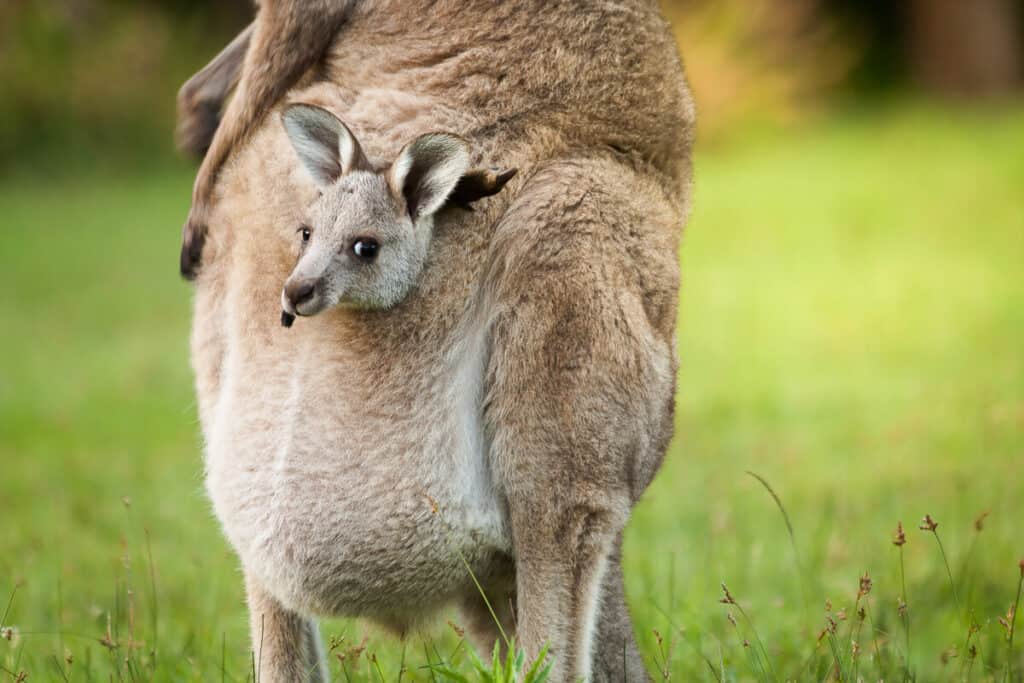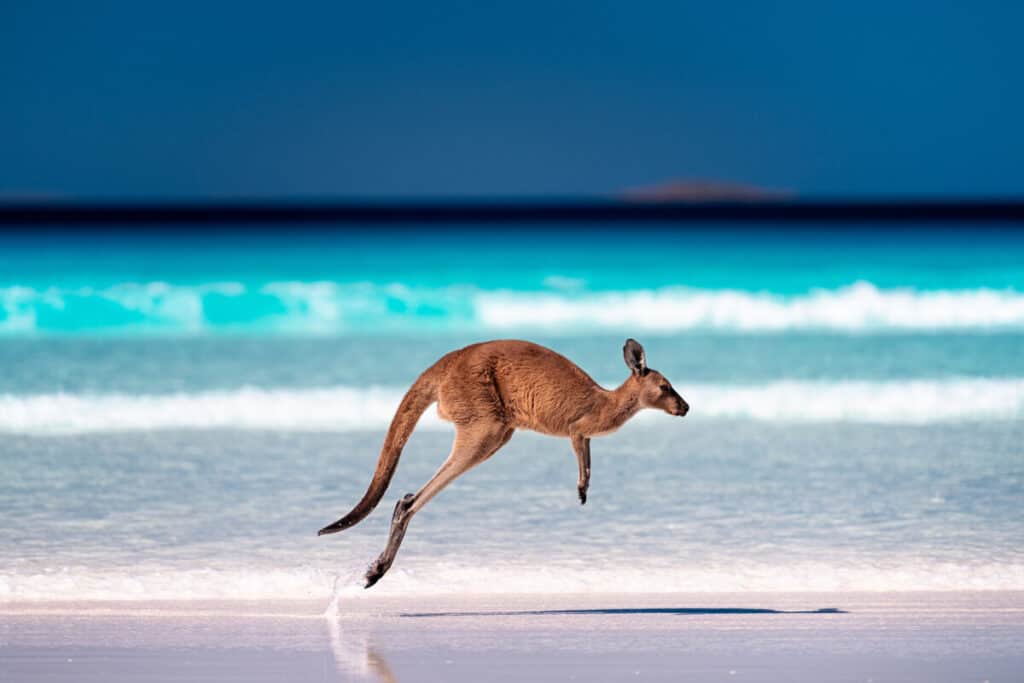The kangaroo is a marsupial native to Australia, known for its powerful hind legs and distinctive hopping gait. Kangaroos are an iconic symbol of Australian wildlife, but their life cycle remains relatively unknown to many. Understanding the lifecycle of kangaroos is important for conservation efforts as well as for understanding the unique adaptations that have allowed them to thrive in their environment.
Kangaroos go through several developmental stages throughout their lifetimes. They begin as tiny joeys, born after only 33 days gestation, weighing less than one gram at birth. The joey then spends up to eight months developing inside its mother’s pouch until it is ready to emerge and hop on its own.
As adults, kangaroos can reach heights of over six feet tall and weigh up to 200 pounds, making them the largest marsupials in existence today. Despite their size, they remain agile and able to traverse long distances with ease thanks to their powerful leg muscles and specialized anatomy.

Birth And Early Development
With a gestation period of only 30-40 days, kangaroos are one of the shortest-lived marsupials in terms of pregnancy.
After being born at a size equivalent to that of a jelly bean, the joey crawls its way up the mother’s belly and into her pouch where it latches onto one of four teats for milk.
During this time, the joey is completely dependent on its mother as it develops both physically and mentally.
Growth milestones during this stage include reaching the point where they can open their eyes which occurs around day 55 post-birth and becoming strong enough to poke their head out of their mother’s pouch by day 120.
Environmental factors play an important role in early development with joeys from areas with harsher climates growing more quickly than those from milder ones due to increased nutrient intake from richer vegetation.
As they continue to grow, joeys will gradually spend less time inside the pouch until finally emerging altogether between six months to over a year old depending on species and sex.
Life Inside The Pouch
The pouch of a kangaroo plays an essential role in the development of its offspring. After birth, the newborn joey crawls into the mother’s pouch where it will continue to develop and grow for several months.
The first few weeks inside the pouch are critical as this is when the joey’s organs and systems begin to form and mature. During this time, the joey relies solely on maternal care for nourishment and protection.
As the joey continues to grow, so too does the pouch. Pouch development is directly linked to joey growth, with larger joeys requiring bigger pouches. The interior lining of the pouch also changes during this process, becoming less furry and more leathery over time.
By around six months old, most joeys are ready to leave their mother’s pouch for short periods but still return for regular feeds until they become fully independent at around eight or nine months old.
Kangaroo Chronicles: Unveiling Their Characteristics
Emergence From The Pouch
During the early stages of their life, kangaroos remain inside their mother’s pouch. This is where they receive nourishment and protection from external factors that could potentially harm them. However, once they reach a certain age, it becomes necessary for them to emerge from the safety of their mother’s pouch and start exploring the world around them.
Interestingly enough, not all kangaroo joeys are born at the same time. In fact, female kangaroos have been known to delay giving birth until environmental conditions are just right.
Once born, however, these young marsupials go through several behavioral changes as they grow older and begin to explore more of their surroundings. Environmental factors also play a significant role in shaping the development and behavior of kangaroos as they mature into adulthood.
- The impact of droughts on kangaroo populations
- How climate change affects the growth rate of joeys
- The effects of habitat destruction on kangaroo behavior
As they continue to develop and adapt to their environment, it is important for us to understand how our actions can affect these creatures’ livelihoods. By taking steps towards preserving natural habitats and minimizing human interference with wildlife populations, we can ensure that future generations will be able to observe these fascinating animals in their natural habitats.
Kangaroos’ Predators Revealed: Unmasking the Threats
Adolescence And Maturity
Adolescence in kangaroos typically begins around 12 to 18 months of age. During this phase, physical changes become more apparent as the young kangaroo grows and develops. They begin to explore their surroundings beyond their mother’s pouch, engaging in playful activities that help them develop necessary skills for survival.
However, social behavior also becomes increasingly important during adolescence. Young male kangaroos often engage in sparring matches with each other to establish dominance and hierarchy within a group. Female kangaroos tend to form close bonds with their mothers and other female relatives, which they maintain throughout their lives.
As individuals reach maturity at around three years old, these social behaviors play an even larger role in daily life, especially when it comes to mating and raising offspring.
As they mature, adult kangaroos continue to display unique social behaviors depending on their gender and reproductive status. Males may participate in ‘boxing’ matches or loud vocalizations known as ‘booming’ calls to attract females. Females often gather together in large groups called mobs for protection from predators while simultaneously caring for their joeys.
These complex social behaviors are essential for successful reproduction and maintaining a healthy population of kangaroos in the wild without human interference or habitat destruction.
Red Kangaroos’ Predators Exposed: Unveiling the Threats
Reproduction And Parenting
Reproduction and parenting in kangaroos are fascinating aspects of their lifecycle.
Breeding season typically falls between December to June, when the weather is favorable for reproduction. During this period, male kangaroos engage in fierce battles to establish dominance over the females. The dominant male has a higher chance of mating with multiple females.
Female kangaroos have a unique reproductive system where they can delay the development of an embryo until environmental conditions improve.
Kangaroo social structure plays a crucial role in parenting. After giving birth, female kangaroos carry their young joeys in their pouches for several months until they mature enough to survive on their own.
Kangaroo mothers produce two types of milk; one type is high in protein and fat content that helps the joey grow quickly, while the other type is low-fat milk primarily used as hydration during hot days. Additionally, mother kangaroos also lick their joeys’ fur regularly to keep them clean and stimulate growth.
Overall, kangaroo parenting demonstrates how intricate animal behavior is influenced by both internal and external factors such as physiology and environment without human intervention.
Adaptations For Survival
Kangaroos are known for their unique adaptations that enable them to survive in the harsh Australian environment. One of these adaptations is their specialized digestive system, which allows them to extract as much water and nutrients as possible from tough and fibrous vegetation. They also have powerful hind legs that allow them to move quickly across long distances and jump up to three times their own body length, enabling them to escape predators or traverse challenging terrain.
Habitat requirements play a crucial role in kangaroo survival. They require large areas with access to sufficient food, water, shelter, and space. Kangaroos prefer open grassy plains with scattered trees or shrubs where they can easily spot potential threats, while still having cover nearby if needed.
Predator-prey interactions between kangaroos and animals such as dingoes, foxes, and feral cats pose significant threats to their survival. However, due to their speed and agility, kangaroos can outrun most predators when necessary. In addition, large groups of kangaroos may work together by surrounding an attacker and using powerful kicks from their hind legs to fend off the predator.

Conservation And Protection Efforts
The need for conservation and protection efforts for kangaroos cannot be overstated. These iconic marsupials have been facing numerous threats, including habitat loss due to land clearing, bushfires, and road development. As a result, some species of kangaroos are considered vulnerable or endangered.
To address this issue, reintroduction programs have been established in different parts of Australia, where captive-bred individuals are released into the wild to increase population numbers. Additionally, habitat restoration initiatives have been implemented to provide suitable habitats for these animals.
The success of such programs depends on various factors such as genetic diversity and availability of resources. Despite challenges in implementation and monitoring effectiveness, these conservation efforts remain crucial in ensuring that future generations can witness the unique life cycle of kangaroos.
Efforts towards protecting and conserving the kangaroo populations must continue if we want them to thrive sustainably over time. Although there is no single solution to safeguard their survival, it is clear that more needs to be done regarding habitat preservation and reducing human impact on their natural environment.
By supporting ongoing conservation programs aimed at preserving the delicate balance between humans and wildlife while promoting sustainable living practices, we can contribute towards better outcomes for both people and kangaroos alike without compromising each other’s interests.
It is our collective responsibility to ensure that these magnificent creatures will continue to grace us with their presence long into the future.
Conclusion
The kangaroo lifecycle is a fascinating process that has intrigued scientists and animal enthusiasts alike.
From birth to maturity, these marsupials go through an incredible journey of development and adaptation.
The early stages of life are spent inside the mother’s pouch, where they develop rapidly before emerging into the world.
As adolescents and adults, kangaroos continue to evolve and adapt to their environment, using their powerful hind legs for mobility and defense against predators.
Reproduction and parenting also play important roles in this unique lifecycle, as female kangaroos carry their young in their pouches until they are ready to venture out on their own.
Overall, the kangaroo lifecycle showcases some of nature’s most remarkable adaptations for survival.
As humans continue to encroach on their habitats, it is crucial that we take steps to protect these amazing creatures from extinction.
Through conservation efforts and education about their importance in the ecosystem, we can ensure that future generations will be able to witness the wonder of the kangaroo lifecycle firsthand.

